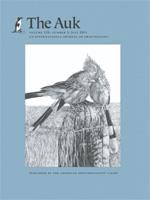As in 1910, just over 100 General Notes were published in The Auk during 1911. In many respects, reading those notes is like reading e-mail messages in your inbox: most are a few sentences long while a few are over a page long. New information was reported on birds from a total of 26 states, one province, and Greenland. As usual, Massachusetts had the most reports (19), followed by South Carolina (9) and Maine and Pennsylvania (6 each). Many of the reports from South Carolina were made by Arthur Trezevant Wayne (1863–1930). Author of Birds of South Carolina (1910), Wayne spent much of his adult life as a field ornithologist, venturing forth to search for birds on nearly a daily basis. Although he never attended an AOU meeting, he was elected to Fellow in 1928.
Charles T. Ramsden continued to make reports from Cuba: a colony of Magnificent Frigatebirds (Fregata magnificens) near Guantanamo Bay (Auk 28:254), nesting of the Olive-capped Warbler (Dendroica pityophila) in eastern Cuba (28:268–269), the fifth record of Green Heron (Butorides virescens) (28:367), and possibly the first record of White-crowned Sparrow (Zonotrichia leucophrys) (28:448). In New England, Northern Mockingbirds (Mimus polyglottos) were beginning to nest more commonly, sightings of Black (Coragyps atratus) and Turkey (Cathartes aura) vultures were still of interest, and winter of 1910–1911 was a flight year for Evening Grosbeaks (Coccothraustes vespertinus). The previous flight winter was 1903–1904, and the next one was 1915–1916. Three notes dealt with sightings of Great Egrets (Ardea alba) during summer of 1910 in eastern Massachusetts. One of the observers was Joseph Archibald Hagar (1896–1989), who was only 15 years old at the time. Archie, as he was known to friends, would serve as the state ornithologist of Massachusetts from 1938 to 1959 and was an Elected Member in the AOU.
During fall of 2010, a disease outbreak killed an estimated 200,000 birds at the Great Salt Lake in Utah (28:274), this being the first report of a massive die-off in the western United States. There had been a serious drought and the lake level was quite low. The water was described as “stagnant and filthy.” After examining some dead birds, “Mr. J. H. Mohler, Chief of Division of Pathology, Washington, D.C., who took the matter up, states that the disease is intestinal coccidiosis—which from appearances is a sort of cholera.” That statement is something of a conundrum: coccidiosis is a disease caused by a protozoan, but it is not supposed to be common in waterfowl. Although avian cholera is today the most common disease in waterbirds in North America and outbreaks now occur with some regularity at the Great Salt Lake, the bacterium that causes that disease was not introduced from Europe until the 1940s. After the report, the great Alexander Wetmore (1886–1978), who at the time worked for the Bureau of Biological Survey, was assigned the task of finding the source of “western duck sickness” (Wetmore 1915). He concluded that it was caused by the toxic action of certain soluble salts found in alkali and pointed to the chlorides of magnesium and calcium as two of the causal agents (Wetmore 1918). It was not until 1930 that avian botulism, caused by the bacterium Clostridium botulinum, was discovered to be the culprit that led to the death of millions of waterbirds in the western United States (Giltner and Couch 1930).
The strangest report came from J. H. Bowles, who reported collecting a troupial on 30 April 1911 in Santa Barbara, California (28:368–369). The bird appeared to have no obvious cage wear, was in a flock of Western Tanagers (Piranga ludoviciana) and Bullock's Orioles (Icterus bullockii), and its stomach was full of “small green canker worms.” Bowles remembered a friend asking about a bird he had seen that was “about the size of a meadowlark, but with a long black tail, black head, and a stripe around its back like a Holstein cow.” Bowles showed his specimen to his friend, who said that he had seen three together in early April. Bowles concluded that there was a “small flight” of troupials that year. Grinnell and Allen (1944) dismissed this record, as well as the one reported by Michener and Michener (1932), as escaped birds. Bowles did not mention what he did with the specimen, but if it was in the Santa Barbara Museum of Natural History it likely was lost during the fire of 1962 (K. Garrett pers. comm.). Recently, three species of troupials have been recognized by the AOU (Banks et al. 2008), so it is unclear which species Bowles actually collected.
John Hooper Bowles (1875–1934) was born in Boston, Massachusetts, but moved to Tacoma, Washington, in 1896. Except for the period 1909–1912, when he lived in Santa Barbara, he observed and collected birds, eggs, and nests throughout Washington and was generally considered the authority on birds of the Northwest. An Elected Member in the AOU, he assisted William Leon Dawson (1873–1928) with The Birds of Washington, published in 1909.
The funniest piece was from William Brewster, who felt that he needed to apologize to Agnes M. Learned (28:256) for remarks he had made earlier in a paper he published on bittern nuptial plumes from observations made around Concord, Massachusetts (28:90–100). Referring to her paper published in Bird-Lore in 1908, Brewster called her observations on nuptial plumes “rather curiously incomplete.” He apparently had not read (or remembered) a previous paragraph in her paper that explained her observations. His apology is classic Brewster: “I trust that Miss Learned will forgive me for overlooking this essential and gracefully worded passage. How I could have done so is difficult to understand for I read her article no less than three times—as I thought, with care. Apparently my eyes see bittern plumes better in Concord bogs than in printed text; but then light within doors is no longer what it used to be, as every oldish person knows.”





